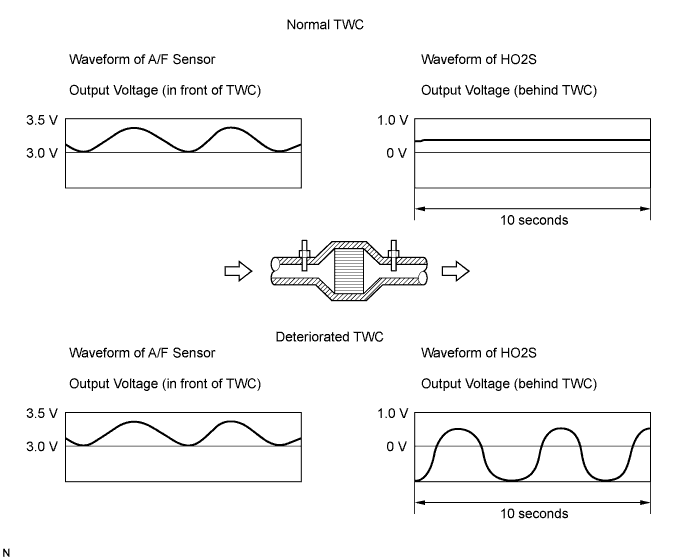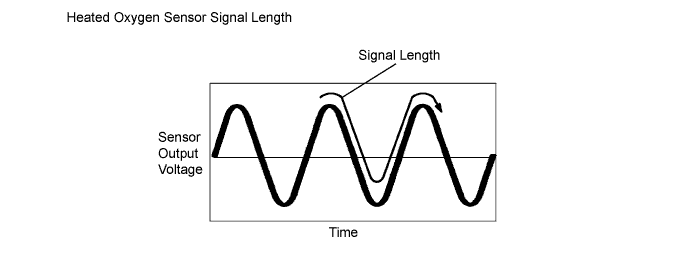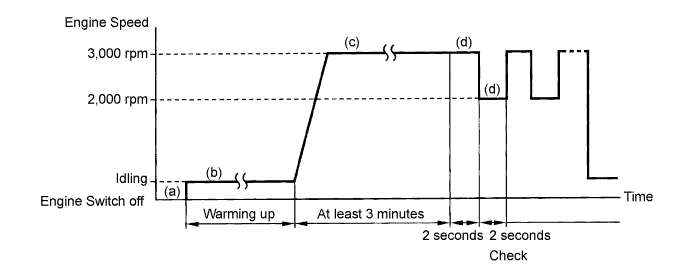Engine. Lexus Gs430, Gs300. Uzs190 Grs190
3Gr-Fe Engine Control System. Lexus Gs430, Gs300. Uzs190 Grs190
CONDITIONING FOR SENSOR TESTING
CHECK ANY OTHER DTCS OUTPUT (IN ADDITION TO DTC P0420 AND/OR P0430)
PERFORM ACTIVE TEST USING INTELLIGENT TESTER (A/F CONTROL)
DTC P0420 Catalyst System Efficiency Below Threshold (Bank 1) |
DTC P0430 Catalyst System Efficiency Below Threshold (Bank 2) |
MONITOR DESCRIPTION
The ECM uses the two sensors, mounted in front of and behind the Three-way Catalytic Converter (TWC), to monitor its efficiency.The first sensor, the Air-Fuel Ration (A/F) sensor (sensor 1), sends pre-catalyst information to the ECM. The second sensor, the Heated Oxygen (HO2) sensor (sensor 2), sends post-catalyst information to the ECM. The ECM compares the information transmitted by these two sensors to determine the efficiency of the TWC performance and its ability to store oxygen.
When the TWC is functioning properly, the variation in the oxygen concentration in the exhaust gas, after it has passed through the TWC, is small. As a result, the voltage output of sensor 2 slowly alternates between the rich and lean signal voltages (shown in the illustration below). As the TWC performance efficiency deteriorates, its oxygen storage capacity decreases, and the variation in the oxygen concentration in the exhaust gas increases. As a result, the sensor voltage output fluctuates frequently.
While the catalyst monitor is running, the ECM measures the signal length of both sensors 1 and 2, and calculate the ratio of the signal lengths to determine the extent of the TWC deterioration. If the deterioration level exceeds the preset threshold, the ECM interprets this as the TWC malfunction. The ECM then illuminates the MIL and sets the DTC.


| DTC No. | DTC Detection Condition | Trouble Area |
| P0420 | After engine and TWC warmed up, and while vehicle driven within set vehicle and engine speeds, waveform of Heated Oxygen (HO2) sensor (bank 1 sensor 2) alternates frequently between rich and lean (2 trip detection logic) |
|
| P0430 | After engine and catalyst are warmed up, and while vehicle is driven within set vehicle and engine speed ranges: Waveform of heated oxygen sensor (bank 2 sensor 2) alternates frequently between rich and lean (2 trip detection logic) |
|
- HINT:
- Bank 1 refers to the bank that includes cylinder No. 1.
- Bank 2 refers to the bank that does not include cylinder No. 1.
- Sensor 1 refers to the sensor closest to the engine assembly.
- Sensor 2 refers to the sensor farthest away from the engine assembly.
CONDITIONING FOR SENSOR TESTING
- HINT:
- Perform the operation with the engine speeds and time durations described below prior to checking the waveforms of the A/F and HO2 sensors. This is in order to activate the sensors sufficiently to obtain the appropriate inspection results.

- (a) Connect the intelligent tester to the DLC3.
(b) Start the engine and warm it up with all the accessories switched OFF, until the engine coolant temperature stabilizes.
(c) Run the engine at engine speed of between 2,500 rpm and 3,000 rpm for at least 3 minutes.
(d) While running the engine at 3,000 rpm for 2 seconds and 2,000 rpm for 2 seconds, check the waveforms of the A/F and HO2 sensors using the tester or scan tool.
- NOTICE:
- The Air-Fuel Ratio (A/F) sensor has an output delay of a few seconds and the Heated Oxygen (HO2) sensor has a maximum output delay of approximately 20 seconds.
| Case | A/F Sensor (Sensor 1) Output Voltage | HO2 Sensor (Sensor 2) Output Voltage | Main Suspected Trouble Area | ||
| 1 | Injection Volume +25 % -12.5 % |  | Injection Volume +25 % -12.5 % |  | - |
| Output Voltage More than 3.35 V Less than 3.0 V |  | Output Voltage More than 0.55 V Less than 0.4 V |  | ||
| 2 | Injection Volume +25 % -12.5 % |  | Injection Volume +25 % -12.5 % |  |
|
| Output Voltage Almost no reaction |  | Output Voltage More than 0.55 V Less than 0.4 V |  | ||
| 3 | Injection Volume +25 % -12.5 % |  | Injection Volume +25 % -12.5 % |  |
|
| Output Voltage More than 3.35 V Less than 3.0 V |  | Output Voltage Almost no reaction |  | ||
| 4 | Injection volume +25 % -12.5 % |  | Injection Volume +25 % -12.5 % |  |
|
| Output Voltage Almost no reaction |  | Output Voltage Almost no reaction |  | ||
- Following the Control the Injection Volume for A/F Sensor procedure enables technicians to check and graph the output voltages of both the A/F and HO2 sensors.
- To display the graph, enter the following menus on the tester: Powertrain / Engine / Data List / AFS B1 S1 and O2S B1 S2 or AFS B2 S1 and O2S B2 S2.
INSPECTION PROCEDURE
- HINT:
- Read freeze frame data using the intelligent tester. Freeze frame data records the engine conditions when malfunctions are detected. When troubleshooting, freeze frame data can help determine if the vehicle was running or stopped, if the engine was warmed up or not, if the air-fuel ratio was lean or rich, and other data from the time the malfunction occurred.
| 1.CHECK ANY OTHER DTCS OUTPUT (IN ADDITION TO DTC P0420 AND/OR P0430) |
Connect the intelligent tester to the DLC3.
Turn the engine switch on (IG) and turn the tester ON.
Enter the following menus: Powertrain / Engine / DTC.
Read DTCs.
- Result:
Display (DTC output) Proceed to P0420 and/or P0430 A P0420 and/or P0430 and other DTCs B
- HINT:
- If any DTCs other than P0420 or P0430 are output, troubleshoot those DTCs first.
|
| ||||
| A | |
| 2.PERFORM ACTIVE TEST USING INTELLIGENT TESTER (A/F CONTROL) |
- Connect the intelligent tester to the DLC3.
- Start the engine and turn the tester ON.
- Warm up the engine at engine speed of 2,500 rpm for approximately 90 seconds.
- On the tester, enter the following menus: Powertrain / Engine / Active Test / Control the Injection Volume for A/F Sensor.
- Perform the Control the Injection Volume for A/F Sensor operation with the engine in an idling condition (press the RIGHT or LEFT button to change the fuel injection volume.)
- Monitor the output voltages of the A/F and HO2 sensors (AFS B1 S1 and O2S B1 S2 or AFS B2 S1 and O2S B2 S2) displayed on the tester.
- HINT:
- The Control the Injection Volume for A/F Sensor operation lowers the fuel injection volume by 12.5 % or increases the injection volume by 25 %.
- Each sensor reacts in accordance with increases and decreases in the fuel injection volume.
| Tester Display (Sensor) | Injection Volume | Status | Voltage |
| AFS B1 S1 or AFS B2 S1 (A/F) | +25 % | Rich | Less than 3.0 |
| AFS B1 S1 or AFS B2 S1 (A/F) | -12.5 % | Lean | More than 3.35 |
| O2S B1 S2 or O2S B2 S2 (HO2) | +25 % | Rich | More than 0.55 |
| O2S B1 S2 or O2S B2 S2 (HO2) | -12.5 % | Lean | Less than 0.4 |
| Status AFS B1 S1 or AFS B2 S1 | Status O2S B1 S2 or O2S B2 S2 | A/F Condition and A/F and HO2 Sensor Conditions | Misfire | Main Suspected Trouble Areas | Proceed to |
| Lean/Rich | Lean/Rich | Normal | - |
| A |
| Lean | Lean/Rich | A/F sensor malfunction | - |
| B |
| Rich | Lean/Rich | A/F sensor malfunction | May occur |
| B |
| Lean/Rich | Lean | HO2 sensor malfunction | - |
| C |
| Lean/Rich | Rich | HO2 sensor malfunction | - |
| C |
| Lean | Lean | Actual air-fuel ratio lean | May occur |
| A |
| Rich | Rich | Actual air-fuel ratio lean | - |
| A |
Rich: During Control the Injection Volume for A/F Sensor, the AFS is consistently less than 3.0 V, and the O2S is consistently more than 0.55 V.
Lean/Rich: During Control the Injection Volume for A/F Sensor of the Active Test, the output voltage of the HO2 sensor alternates correctly.
|
| ||||
|
| ||||
| A | |
| 3.CHECK FOR EXHAUST GAS LEAKAGE |
- OK:
- No gas leakage.
|
| ||||
| OK | ||
| ||